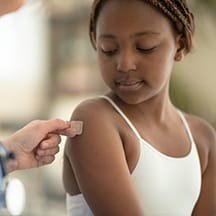During its 2022 community health needs assessment, Arkansas Children's noticed a marked downturn in vaccination. The assessment, which identifies and prioritizes the health needs of a community, showed early childhood vaccinations dropped during the COVID-19 pandemic. Hospital leaders feared vaccine hesitancy was on the rise.
“We heard rumors on the ground that the rate had dropped because people don’t trust vaccines,” said Marisha DiCarlo, PhD, MPH, vice president of community engagement, advocacy and health at Arkansas Children’s. “We developed a pilot program to test that by offering mobile vaccines and trying to get early childhood vaccines caught up.”
DiCarlo said the issue for many families was access to and cost of early childhood vaccines. Focusing on several counties with the lowest immunization rates, Arkansas Children’s worked with schools and local service sites to offer free vaccines through the federal Vaccines for Children (VCF) program. The team vaccinated more than 800 children over 12 months. They found parents were willing to vaccinate when vaccinations were convenient and affordable.
“In some areas of the state, the only VFC provider is the local health unit, which was stretched thin during COVID response,” DiCarlo said. “By and large, it wasn’t that people didn’t want vaccines. If they’re easy to obtain and they’re free, people will get their vaccines.”
More vaccination sites lead to success
Building on these insights, Arkansas Children’s sought to create sustainable solutions. Working with Immunize Arkansas, a nonprofit organization dedicated to improving vaccination rates, the hospital began helping pharmacies, school-based health centers, and medical practices navigate the complex process of becoming VFC providers.
The program addresses practical barriers that previously deterred providers from participating in VFC, such as refrigeration requirements and complex documentation procedures. Through technical assistance and funding support, the hospital is making it feasible for small-town pharmacies and school-based health centers to join the program to provide free vaccines.
The impact has been significant. When the initiative began, 12 counties had a single VFC provider: their local health department. Today, that number has dropped to 10 counties, with eight pharmacies in the process of becoming VFC providers. The hospital aims to further reduce this to seven counties, which would increase access for the 46,000 children who live in those counties.
Finding low-cost solutions for parents
DiCarlo said there is also a perception that parents aren’t accessing health care for their children.
“Many of these children are getting regular health care, either through a pediatrician, general practitioner, or even an urgent care,” DiCarlo said. “But those providers are not offering the shots free of charge if the provider isn’t a VFC provider. Offered outside of the VFC program, those immunizations may cost hundreds of dollars. We heard stories from families quoted up to $300 for vaccines. One mother said it plainly, ‘if I have to choose between vaccines or food to feed my kids, I’m picking food.’”
Arkansas Children’s is working to eliminate more barriers to access while acknowledging the unique challenges of serving rural communities.
“In reality, getting to zero counties with limited access is unlikely in Arkansas,” DiCarlo said. “We have some counties with such small populations. But I think if we could get to five, we could really close that gap.”


